Nina Simone – The High Priestess of Soul
Originally Posted on Blues For a Big Town

It was in the mid 80’s when Toronto’s short lived Village Vanguard North was advertising “Sunday Brunch With Nina Simone ”
The thought of Nina Simone (“The High Priestess of Soul”) performing a concert while the audience threw down eggs benedict was both startling and intriguing. Knowing little about Nina Simone other than some of her stark recordings coupled with the fact that she was reportedly not the most sociable person had me wondering why she was on board with the idea. Surely, based on reputation, she would demand the audience’s utmost attention. And that was something she definitely couldn’t count on while people chomped down food and slurped special coffees.
With little introduction, suddenly there she was – an imposing presence in an African gown and head wrap – The High Priestess Of Soul.
My preconceived notions vanished as Nina “entertained” the audience rather than laying out a concert as such. I recall her doing some of her better known songs, (i.e. “I Loves You Porgy”, “My Baby Just Cares For Me”, “Please Don’t Let Me Misunderstood”), interspersed with “lecture tone” dialogue, (on topics that I either couldn’t decipher or can’t recall), mixed with impromptu displays of African rhythmic dance. I’d never seen anything quite like it. The captivating performance was just as unique as the artist herself.
Knowing much more today about Nina Simone and of her idiosyncrasies makes that show even more fascinating. That is, for all the deeply rooted anger that Simone was and is known for, the show was an intimate encounter with her audience. It was as if she thrived on the contact with the crowd; that the connection served as a lifeline as she sought to be accepted for who she was – an uncompromising diva to be reckoned with.
Nina Simone’s life story can best be summed up as an extremely influential, original artist who was scarred by personal, racial and social injustices (both real and imagined).
A non-conformist, Simone confronted said injustices directly and as swiftly as possible. And, at the same time, she used those same wrongdoings to fuel her art. A product and barometer of the times, Nina came to prominence in the 60’s. Although she still continued to record and perform through to the end of her life, it was that decade that defined both her artistry and her social consciousness. If Simone stopped performing and recording immediately following those years she still would have earned her place in the annals of modern music. Accordingly, it truly can be said that, as one writer stated, “to really understand the 60’s, you had to hear Nina”.
Simone, (1933-2003), was born Eunice Kathleen Waymon in Tryon, North Carolina.

The sixth of eight children, Simone was part of a respected family. Her mother was a Methodist minister and worked as a domestic while her father helped support the family as a handy man. While not well off by any means, the family lived comfortably, and were mainstays of the Tyron black community.
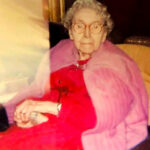
Nina was a true child prodigy as a gifted pianist at the age of 4. It was a year later that young Eunice started both accompanying her mother at Sunday services as well the church choir. Coincidentally, around this time Eunice started taking lessons from a local piano teacher, Murial Mazzanovich. “Miz Mazzy” or “my white momma”, as Simone referred to Mazzanovich, unlocked her passion for the masters: Bach, Chopin, Brahms, Beethoven, and Schubert. She also served as inspiration for Nina’s plans to become America’s first great black female concert pianist.
Word of Nina’s extraordinary talent spread quickly with people travelling from miles around to attend her piano recitals.
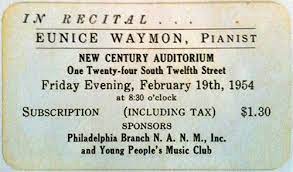
One such recital at a local library when Nina was 11 first raised her sensitivity to racism. It happened that Simone’s parents were told to move from their front row seats to make room for white patrons. In one of a number of acts of defiance in her life, Simone refused to continue unless her parents were allowed to return to their rightful place.
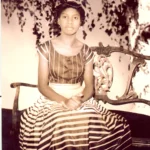
In her quest to fulfill her concert pianist dreams Simone attended the summer program at The Julliard School in New York City in hopes of readying herself for an audition for acceptance at The Curtis Institute Of Music in Philadelphia. Nina’s parents were so sure of her impending approval that they moved the family to Philadelphia. However, despite a well-received performance, her application was denied thus leading Simone to believe that it was due to racial discrimination. Although there was no evidence to support her belief, it nonetheless left a lifelong wound and further embittered her perception of the world. A world in which she was firmly convinced racially motivated biases played a major role in her life going forward.
Needing money to continue her studies, Simone took a job at an Atlantic City dive, The Midtown Bar & Grill, as a cocktail pianist.
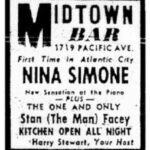
Eunice Waymon was now officially “Nina Simone” as she sought to keep the fact that she was playing “the Devil’s music” a secret from her minister mother. Her initial, all instrumental, repertoire consisted of Gospel numbers, mixed with Jazz standards, and Classical pieces. However, Nina was told that to keep her job that she would have to sing. Although a new experience, Simone quickly adapted, unleashing her husky, expressive, smooth contralto voice – typically, the lowest register of the female range – first on a set of songs she learned from a Billie Holiday album and later expanded her collection to include Blues, Folk, and Show tunes – all performed in typical Simone fashion. That is, although she played various genres, she wasn’t confined by their boundaries thereby making all that she sang a deeply personal statement.
Simone moved to New York in the mid fifties and established her reputation in clubs in Greenwich Village.
The Village, known for its progressive attitudes, proved to be a perfect setting for Simone’s mix of Jazz, Folk, and Blues always suspended by a Classical touch. Not only did she enjoy rave reviews for her performances, but with her staunch stance on all race related matters, Simone also attracted the attention of some of Black America’s outspoken literary minds including James Baldwin.
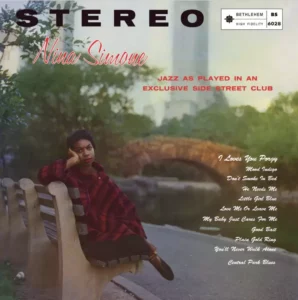
A person who had his hand on the musical pulse of the times, and recognized the brilliance of her Village performances, was Syd Nathan of King Records who signed Simone to his Bethlehem subsidiary. Due to disagreements regarding the label’s promotional efforts, their partnership would only produce one album – Little Girl Blue, (AKA Jazz As Played In An Exclusive East Side Street Club). The release, an auspicious debut consisting of primarily Jazz and Gospel flavoured entrees with Classical sensibilities, was recorded in 1957, (when Nina was 24 years old), and released in 1959. It yielded the definitive take of “I Loves You Porgy” – even eclipsing Billie Holiday’s version – that earned Simone a #2 R&B, #18 Pop hit. It should be noted that Simone identified with the song, (“I love you Porgy / Don’t let him take me / Don’t let him handle me with his hot hands…”), and it would be a staple of her live set going forward.
More than 30 releases, (not including compilations), followed on other labels including Colpix, Phillips, RCA, Verve, and Elektra, as she recorded prolifically through to 1993.

The bulk of those releases were in her zenith, the 60’s. It was in the 60’s that Simone not only released some of the best albums of her career but also established herself as a true star. Simone was a critics’ darling and a performer who could consistently sell out a show no matter the venue.
Playing a vital role in Simone’s rise to fame was her manager / husband Andrew Stroud. Stroud, an admirer from afar was a tough New York City detective when they met. After marrying Simone, Stroud retired from the force to manage her career. Stroud was an unrelenting driver who had well laid plans to make Simone successful. Stroud had Nina working constantly, capitalized on every opportunity, and succeeded in securing a number of high profile gigs. (Notable in his efforts is that Stroud put up his own money to finance a concert at Carnegie Hall thereby fulfilling Nina’s lifelong dream of playing the performance hall). Those dates were successful in their own right, and, in addition, helped fuel her album sales. Nina released 7 critically acclaimed albums in that time period – primarily on Colpix, a label that allowed Simone creative freedom:
Nina Simone Live At Newport (1960)
Nina Simone Live At The Village Gate (1962)
Nina Simone Live At Carnegie Hall (1963)
Nina Simone In Concert (1964)
I Put A Spell On You (1965)
Nina Simone Sings The Blues (1967)
‘Nuff Said (1968)
It’s no coincidence that the majority of the albums are recordings of live performances because it was in a live setting that Simone excelled.
Here, she stepped outside of herself, and was left to her own devices to feed off of transfixed audiences with improvisational displays of virtuosity. Some of Nina’s best known songs are contained on the above mentioned albums, (in addition to other 60’s releases), including:
“Trouble In Mind”
“Work Song”
“Love Me Or Leave Me”
“Don’t Let Me Be Misunderstood”
“Feeling Good”
“Sinnerman”
“I Put A Spell On You”
“Backlash Blues”
“Mississippi Goddam”
“To Be Young Gifted And Black”
But all was not sunshine and roses in the Simone / Stroud household.
Despite living very well in a Mount Vernon NY house, complete with a butler and a maid, in an upscale neighbourhood, and happily bringing a daughter into the world, trouble was lurking around the corner. Nina was growing weary; she complained of a feeling of emptiness and of the constant touring, while Stroud refused to let up. Making matters worse, Simone was subjected to physical abuse at the hands of her husband on more than one occasion. (One particularly inglorious moment for Stroud occurred after he saw a fan pass Nina a note at one of her concerts. In a fit of jealousy, Stroud proceeded to beat Nina in the dressing room and on the ride home. Once at home, he supposedly tied Nina to a chair as he continued to beat her).
The beatings, no doubt added to Nina’s stated feeling of emptiness, and resulted in Nina acting out her frustrations in public.
While Nina was a strong woman, she was easily wounded by perceived injustices. The smallest incident could set her off resulting in rather inappropriate behaviour. For example, she became known for scolding her audience, in mid song, if she thought they weren’t being attentive. In other instances she would leave the stage for lengths of time for reasons known only to her.
Looking to fill the void coincided with current events that reawakened Simone’s acute sensitivity to racism and sparked Simone’s anger. One such incident cut deeply – the white supremacist terrorist bombing of the 16th Street Baptist Church in Birmingham, Alabama, on Sunday, September 15, 1963 that resulted in the death of 4 young girls.
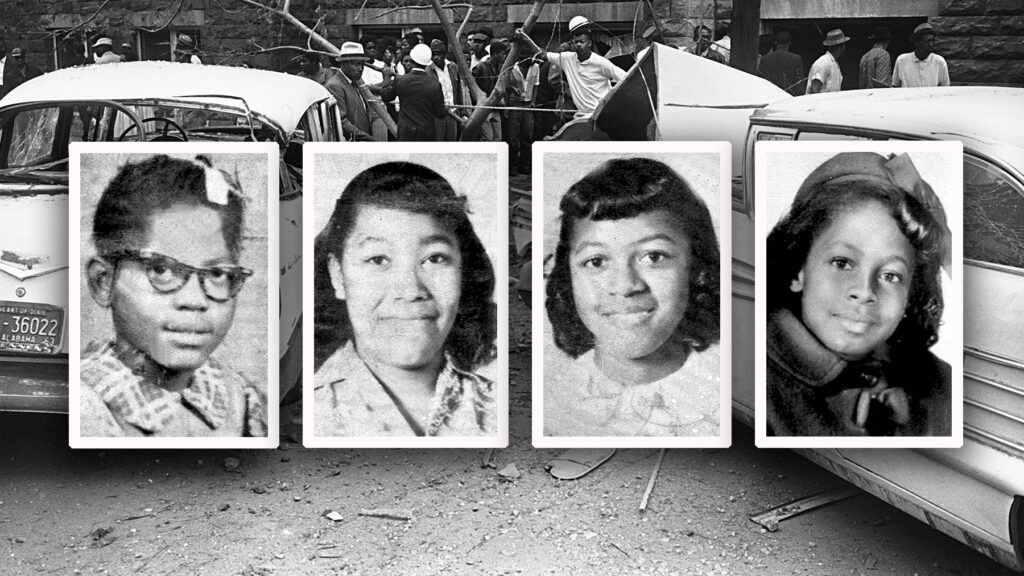
In response, it took an enraged Simone one hour to write “Mississippi Goddam”
“Alabama’s gotten me so upset
Tennessee made me lose my rest
And everybody knows about Mississippi Goddam
Can’t you see it
Can’t you feel it
It’s all in the air
I can’t stand the pressure much longer
Somebody say a prayer
Alabama’s gotten me so upset
Tennessee made me lose my rest
And everybody knows about Mississippi Goddam”
The fuse had been lit as Nina became consumed with the Civil Rights Movement and her associated hate.
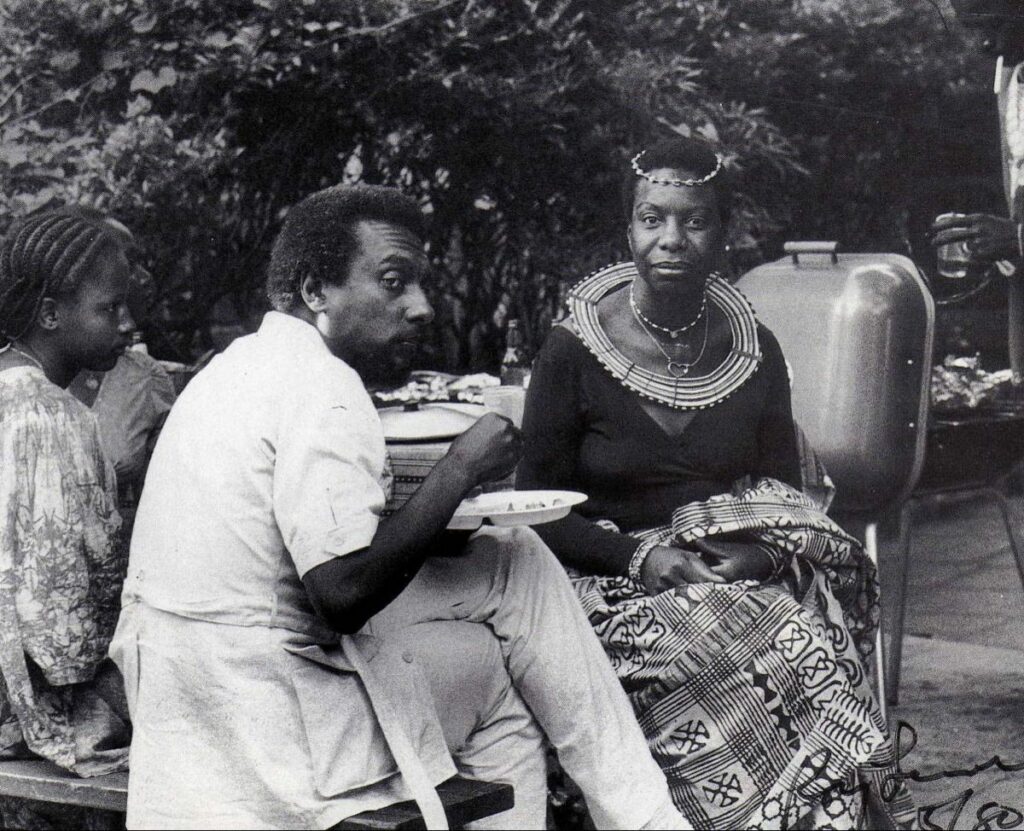
As an artist, her immediate response was a desire to only sing civil rights songs, (“the important ones”), because as Simone summed it up “How can you be an artist and not reflect the times?”. Accordingly, Simone became a major voice of the Black Power Movement as she aligned herself not with Martin Luther King – who upon meeting him for the first time Simone let him know that “I’m not non-violent” – but with Stokely Carmichael whose fierce philosophies coincided with Simone’s inclinations.
But as the 60’s were drawing to a close Simone started paying for her violence leaning civil rights stance in that promoters were reluctant to book her. In addition, her relationship with her husband – who wasn’t totally on board with her Black Nationalist posturing in the first place – was becoming more and more frayed. The result was that Nina left Stroud in 1970.
Without Stroud’s grounding and direction Simone’s career was at a standstill.
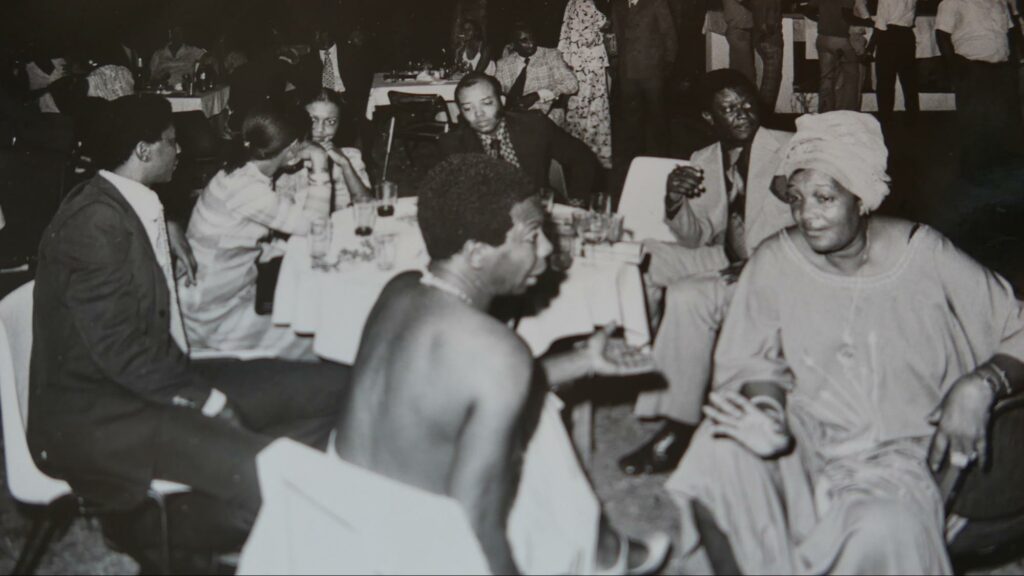
In interviews she confided that she felt abandoned by the Movement and that her preoccupation with civil rights activities had sabotaged her career. She went on to say, as a result, that she could no longer perform the so-called “important songs”.
After flailing around rudderless for a number of years Simone took her 12 year old daughter and moved first to Barbados and then to Liberia in 1974, never to return to the States on a permanent basis for the rest of her life. In Liberia she sought refuge from her professional life and in the two years that she lived there she – for all intents and purposes – retired; never playing a gig, or the piano for that matter. At the same time her behaviour was becoming more and more erratic, (including beating her daughter without provocation and / or for the slightest indiscretion), as her life appeared to be spinning out of control.
After her daughter moved back to the States to live with her father, Simone moved to Switzerland, (playing a somewhat confounding but well-received set at The Montreux Jazz Festival), and then to France in the hopes of reviving her career.
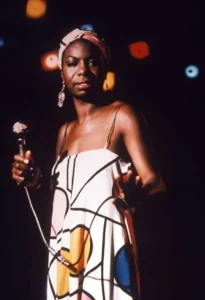
Simone eventually ended up in Paris with a resident booking at a small club for $300 a night – unbecoming for an international star of her stature to say the least. Her performances alternated between genius and disaster. Compounding the problem was that Simone was drinking excessively, further altering her inconsistent behaviour, while not minding the necessities required for healthy living.
In the mid 80’s a Dutch admirer and friend Gerrit de Bruin happened to catch one of her shows, and along with Simone’s long time guitarist Al Schackman, came to her rescue. Not only did de Bruin find her a reasonable place to live and buy her clothes, (“she was dressed in rags”), but he also introduced her to a doctor who diagnosed Simone as manic depressive and bi-polar. With the help of the prescribed medication Simone’s condition started to stabilize allowing her to resume her career in earnest.
Although she would never achieve the heights that she enjoyed in the 60’s, Simone would nevertheless continue to perform and record a dozen more albums – including the fine 1984 set Live At Ronnie Scott’s, London’s famous Jazz club. (Nina would release her final album, A Single Woman, in 1993).
Simone would continue to be a major influence on artists of all genres because her music and her songs refused categorization and appealed to many.
Part of that attraction was Nina’s eclectic tastes as demonstrated by covering seemingly diverse artists such as Bob Dylan and The Bee Gees, and even recording a selection from the musical “Hair”. Despite her personal issues, Nina Simone was one of the most celebrated singers of her day, and of any day. Above all else, it could rightfully be said that she made you believe. As a NY Times review of her 1992 concert at Carnegie Hall stated:
“Whether she was singing love songs or protest songs, Ms. Simone performed as though her soul was living out each injustice and heartache”
NY Times 1992
Nina Simone was living her final years battling lung cancer, and a few days before her death Simone was awarded an honorary degree by the Curtis Institute of Music, the music school that had refused to admit her as a student as a teenager. Nina Simone died in her sleep at home in Carry-le-Rouet France in 2003.
And, among a number of other awards, after several years of getting slighted from a spot, Nina Simone was finally inducted into the Rock and Roll Hall of Fame in 2018.
A NINA SIMONE PLAYLIST

fantastic, great voice
love the interview on freedom…interesting read…great music selection.